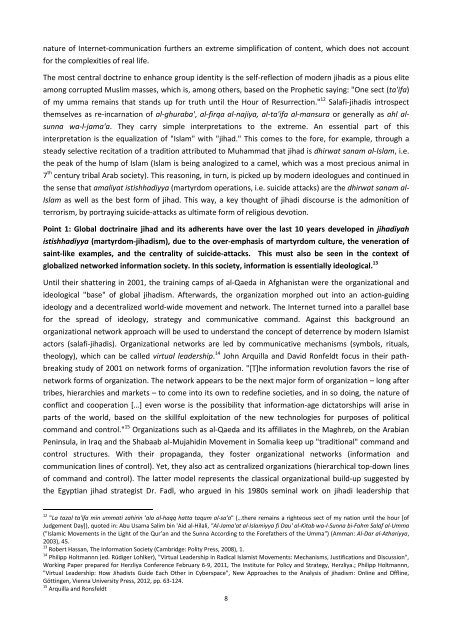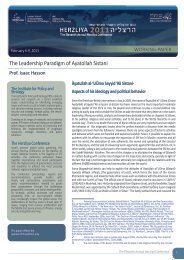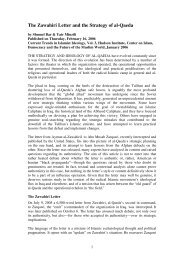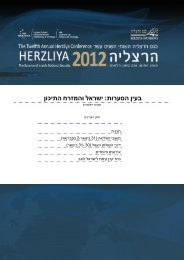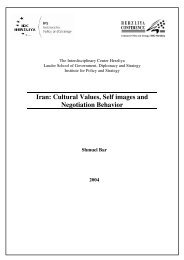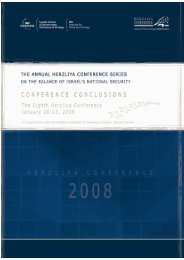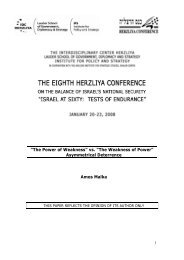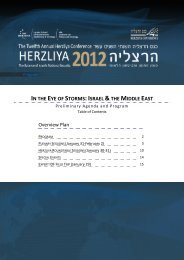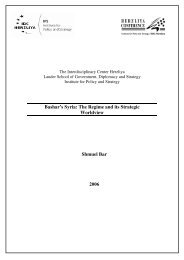Classical Islamic Paradigms of Deterrence and their Expression in ...
Classical Islamic Paradigms of Deterrence and their Expression in ...
Classical Islamic Paradigms of Deterrence and their Expression in ...
Create successful ePaper yourself
Turn your PDF publications into a flip-book with our unique Google optimized e-Paper software.
nature <strong>of</strong> Internet-communication furthers an extreme simplification <strong>of</strong> content, which does not accountfor the complexities <strong>of</strong> real life.The most central doctr<strong>in</strong>e to enhance group identity is the self-reflection <strong>of</strong> modern jihadis as a pious eliteamong corrupted Muslim masses, which is, among others, based on the Prophetic say<strong>in</strong>g: "One sect (ta'ifa)<strong>of</strong> my umma rema<strong>in</strong>s that st<strong>and</strong>s up for truth until the Hour <strong>of</strong> Resurrection." 12 Salafi-jihadis <strong>in</strong>trospectthemselves as re-<strong>in</strong>carnation <strong>of</strong> al-ghuraba', al-firqa al-najiya, al-ta'ifa al-mansura or generally as ahl alsunnawa-l-jama'a. They carry simple <strong>in</strong>terpretations to the extreme. An essential part <strong>of</strong> this<strong>in</strong>terpretation is the equalization <strong>of</strong> "Islam" with "jihad." This comes to the fore, for example, through asteady selective recitation <strong>of</strong> a tradition attributed to Muhammad that jihad is dhirwat sanam al-Islam, i.e.the peak <strong>of</strong> the hump <strong>of</strong> Islam (Islam is be<strong>in</strong>g analogized to a camel, which was a most precious animal <strong>in</strong>7 th century tribal Arab society). This reason<strong>in</strong>g, <strong>in</strong> turn, is picked up by modern ideologues <strong>and</strong> cont<strong>in</strong>ued <strong>in</strong>the sense that amaliyat istishhadiyya (martyrdom operations, i.e. suicide attacks) are the dhirwat sanam al-Islam as well as the best form <strong>of</strong> jihad. This way, a key thought <strong>of</strong> jihadi discourse is the admonition <strong>of</strong>terrorism, by portray<strong>in</strong>g suicide-attacks as ultimate form <strong>of</strong> religious devotion.Po<strong>in</strong>t 1: Global doctr<strong>in</strong>aire jihad <strong>and</strong> its adherents have over the last 10 years developed <strong>in</strong> jihadiyahistishhadiyya (martyrdom-jihadism), due to the over-emphasis <strong>of</strong> martyrdom culture, the veneration <strong>of</strong>sa<strong>in</strong>t-like examples, <strong>and</strong> the centrality <strong>of</strong> suicide-attacks. This must also be seen <strong>in</strong> the context <strong>of</strong>globalized networked <strong>in</strong>formation society. In this society, <strong>in</strong>formation is essentially ideological. 13Until <strong>their</strong> shatter<strong>in</strong>g <strong>in</strong> 2001, the tra<strong>in</strong><strong>in</strong>g camps <strong>of</strong> al-Qaeda <strong>in</strong> Afghanistan were the organizational <strong>and</strong>ideological "base" <strong>of</strong> global jihadism. Afterwards, the organization morphed out <strong>in</strong>to an action-guid<strong>in</strong>gideology <strong>and</strong> a decentralized world-wide movement <strong>and</strong> network. The Internet turned <strong>in</strong>to a parallel basefor the spread <strong>of</strong> ideology, strategy <strong>and</strong> communicative comm<strong>and</strong>. Aga<strong>in</strong>st this background anorganizational network approach will be used to underst<strong>and</strong> the concept <strong>of</strong> deterrence by modern Islamistactors (salafi-jihadis). Organizational networks are led by communicative mechanisms (symbols, rituals,theology), which can be called virtual leadership. 14 John Arquilla <strong>and</strong> David Ronfeldt focus <strong>in</strong> <strong>their</strong> pathbreak<strong>in</strong>gstudy <strong>of</strong> 2001 on network forms <strong>of</strong> organization. "[T]he <strong>in</strong>formation revolution favors the rise <strong>of</strong>network forms <strong>of</strong> organization. The network appears to be the next major form <strong>of</strong> organization – long aftertribes, hierarchies <strong>and</strong> markets – to come <strong>in</strong>to its own to redef<strong>in</strong>e societies, <strong>and</strong> <strong>in</strong> so do<strong>in</strong>g, the nature <strong>of</strong>conflict <strong>and</strong> cooperation […] even worse is the possibility that <strong>in</strong>formation-age dictatorships will arise <strong>in</strong>parts <strong>of</strong> the world, based on the skillful exploitation <strong>of</strong> the new technologies for purposes <strong>of</strong> politicalcomm<strong>and</strong> <strong>and</strong> control." 15 Organizations such as al-Qaeda <strong>and</strong> its affiliates <strong>in</strong> the Maghreb, on the ArabianPen<strong>in</strong>sula, <strong>in</strong> Iraq <strong>and</strong> the Shabaab al-Mujahid<strong>in</strong> Movement <strong>in</strong> Somalia keep up "traditional" comm<strong>and</strong> <strong>and</strong>control structures. With <strong>their</strong> propag<strong>and</strong>a, they foster organizational networks (<strong>in</strong>formation <strong>and</strong>communication l<strong>in</strong>es <strong>of</strong> control). Yet, they also act as centralized organizations (hierarchical top-down l<strong>in</strong>es<strong>of</strong> comm<strong>and</strong> <strong>and</strong> control). The latter model represents the classical organizational build-up suggested bythe Egyptian jihad strategist Dr. Fadl, who argued <strong>in</strong> his 1980s sem<strong>in</strong>al work on jihadi leadership that12 "La tazal ta'ifa m<strong>in</strong> ummati zahir<strong>in</strong> 'ala al-haqq hatta taqum al-sa'a" (…there rema<strong>in</strong>s a righteous sect <strong>of</strong> my nation until the hour [<strong>of</strong>Judgement Day]), quoted <strong>in</strong>: Abu Usama Salim b<strong>in</strong> 'Aid al-Hilali, "Al-Jama'at al-Islamiyya fi Dau' al-Kitab wa-l-Sunna bi-Fahm Salaf al-Umma("<strong>Islamic</strong> Movements <strong>in</strong> the Light <strong>of</strong> the Qur’an <strong>and</strong> the Sunna Accord<strong>in</strong>g to the Forefathers <strong>of</strong> the Umma") (Amman: Al-Dar al-Athariyya,2003), 45.13 Robert Hassan, The Information Society (Cambridge: Polity Press, 2008), 1.14 Philipp Holtmannn (ed. Rüdiger Lohlker), "Virtual Leadership <strong>in</strong> Radical Islamist Movements: Mechanisms, Justifications <strong>and</strong> Discussion",Work<strong>in</strong>g Paper prepared for Herzliya Conference February 6-9, 2011, The Institute for Policy <strong>and</strong> Strategy, Herzliya.; Philipp Holtmannn,"Virtual Leadership: How Jihadists Guide Each Other <strong>in</strong> Cyberspace", New Approaches to the Analysis <strong>of</strong> jihadism: Onl<strong>in</strong>e <strong>and</strong> Offl<strong>in</strong>e,Gött<strong>in</strong>gen, Vienna University Press, 2012, pp. 63-124.15 Arquilla <strong>and</strong> Ronsfeldt8


